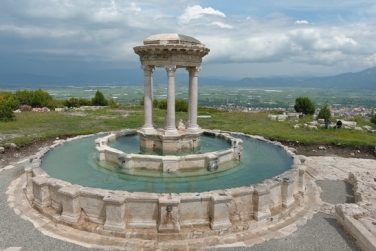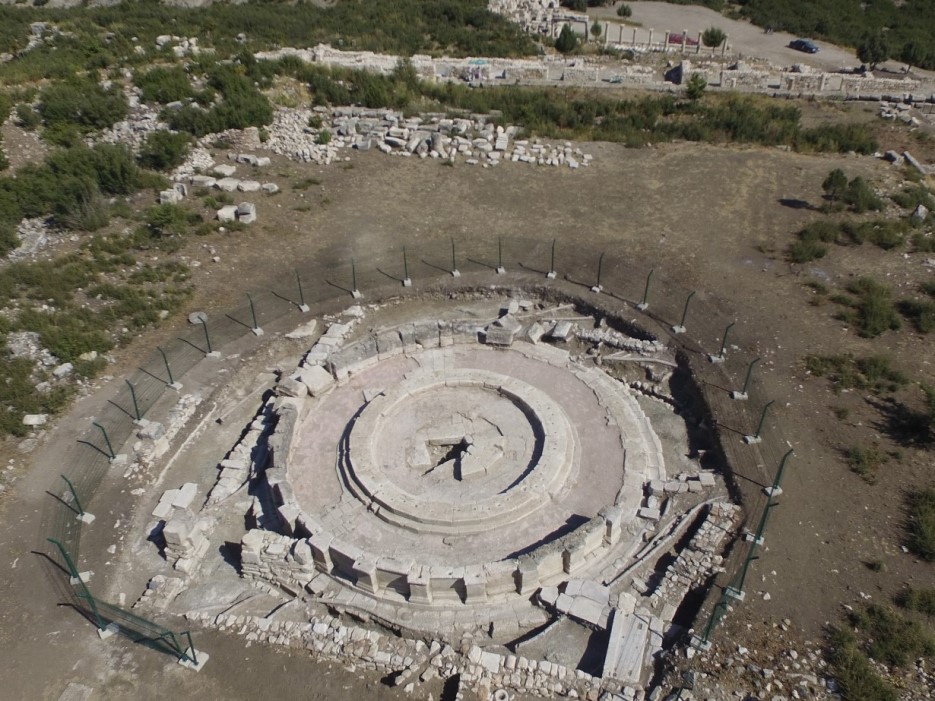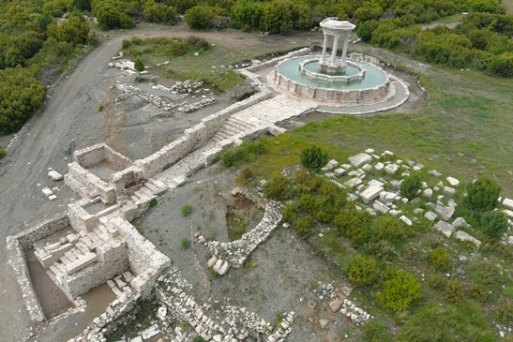Burdur, a city renowned for its archaeological monuments in Türkiye’s Western Anatolian Region, has exciting news. After a nine-month restoration process, fresh and potable spring water is again flowing from the massive fountain in the ancient city of Kibyra, located in Burdur’s Gölhisar district. The restoration of the monumental fountain in Kibyra, the ancient city discovered in 2016 and included in the UNESCO World Heritage Tentative List that same year, took place with the support of the Ministry of Culture and Tourism and the Burdur Governorate.
The 2,000-year-old magnificent fountain of Kibyra was erected during the reign of the Roman Empire. The ancient structure, featuring two pools and located on the third terrace of the Kibyra Ancient City, is believed to have been constructed around 23 AD when the city was rebuilt after a big earthquake and functioned for nearly 700 years. With a height of 7.5 metres and a diameter of 15 metres, the enormous fountain also includes a conical canopy supported by columns. As Kibyra’s first fountain, the massive structure illustrates how the ancient city met its water needs and provides a fine example of the architectural visuality and aesthetics represented in the agora.
Kibyra, “City of Gladiators”
Set on the western slope of the Gölhisar district, Kibyra is situated in a relatively extensive residential area. As one of the most important cities of the Roman civilisation, the architectural remnants found in Kibyra all date to the Roman Imperial Period. A significant characteristic of the site is that each one of the buildings is designed symmetrically so that the view of the others is unobstructed. At the entrance to Kibyra is its stadium; considered one of the most magnificent in ancient Anatolia, the Kibyra stadium could accommodate around 10,000 people and was believed to have hosted epic gladiator competitions – thus bequeathing Kibyra its title, “City of Gladiators.”
Other notable structures in Kibyra are the odeon, featuring a mosaic of Medusa in its orchestra section, and the agora, built around a columned shopping street. In addition, the ancient city’s Roman bath and antique theatre are noteworthy. According to ancient sources, Kibyra’s industries included agriculture, animal husbandry, medicine, iron and ceramic work. The city was believed to have had a cosmopolitan structure and four distinct languages. Accordingly, it is asserted that Kibyra had a robust economy and military.
The Second Ancient City with a Flowing Fountain
The head of the Excavation Committee, Associate Professor Şükrü Özüdoğru, along with an expert team of archaeologists, restorers and architects, participated in the extensive restoration process. During the excavation and restoration of the monumental fountain – with two pools and 192 architectural blocks, 168 of which are original – it was determined that the fountain consisted of three primary units. Observations indicate a round tower ascended in the fountain’s centre, with six columns surrounding it. At the same time, six sculptures of lions and panthers were placed where the water originated. Just two of these statues were discovered during the excavations, and today, the two original sculptures are on display at the Burdur Museum.
Burdur is home to two monumental fountains from antiquity. The first to be discovered was the 1,800-year-old Antonine Fountain in the ancient city of Sagalassos, in the Ağlasun district of Burdur. With the conclusion of the restoration work, Kibyra is the second site to feature a functioning ancient fountain.
In recent years, numerous historical artefacts have been unearthed and brought to museums in Türkiye, where there is a great deal of activity in archaeological excavations, research and rescue. In 2022, 713 archaeological activities unearthed approximately 10,500 artefacts in Türkiye, a top-ranked country worldwide in terms of the number of archaeological excavations.
#Burdur, #Türkiye, #tourism, #Kibyra, #City_of_Gladiators,


